Currently, Google Maps give you the option to customise your route to avoid tolls, freeways, and ferries, but soon, Australians will be able to prioritise routes that generate the lowest carbon emissions.
The revolutionary new move from Google contributes to the tech company’s ongoing efforts to combat climate change, and we couldn’t be more excited to see the feature roll out on Android and iOS later this year.
Once live, the new eco-friendly feature will default all map routes to that with the lowest carbon footprint if comparable routes take around the same time. Should an alternative route be significantly faster, Google will offer commuters a choice and let them compare estimated emissions.
“Soon, Google Maps will default to the route with the lowest carbon footprint when it has approximately the same ETA as the fastest route,” vice president of product Dane Glasgow said in a blog post this week.
“In cases where the eco-friendly route could significantly increase your ETA, we’ll let you compare the relative CO2 impact between routes so you can choose.”
Google calculates eco-friendly routes by taking into account traffic, slopes and a number of other intricate factors. Soon, when you seek out directions on the app, Google will present you with a handful of new metrics, showing on-screen information that says “most fuel-efficient route” and “8% lower CO2 emissions than the fastest route”, for example.
Russell Dicker, a director of product at Google, told media: “What we are seeing is for around half of routes, we are able to find an option more eco-friendly with minimal or no time-cost tradeoff.”
Google’s announcement acknowledged additional climate-conscious changes to its suite of products. In the coming months, a new ‘air quality layer’ will show users more about the air quality on their routes, helping them to determine whether they should keep the windows closed during patches of high smoke, pollution, or allergens.
In addition, Google Maps users will soon be able to compare different methods of transport, ie. car, bikes, public transport and Ubers, in one place.
Read more stories from The Latch and subscribe to our email newsletter.







